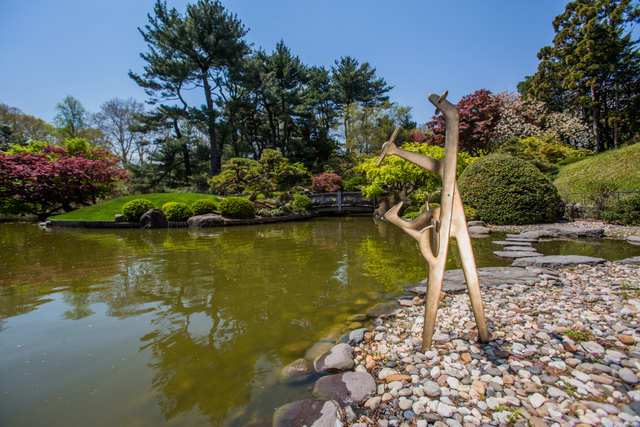 Photo by Liz Ligon. Courtesy of Brooklyn Botanic Garden. “Strange Bird” (1945, cast 1971), bronze, Japanese Hill-and-Pond Garden
Photo by Liz Ligon. Courtesy of Brooklyn Botanic Garden. “Strange Bird” (1945, cast 1971), bronze, Japanese Hill-and-Pond Garden
The Brooklyn Botanic Garden is celebrating the 100th anniversary of its Japanese Hill-and-Pond Garden, the first Japanese garden in an American public garden. This garden was one of the first speciality gardens designed for the Brooklyn Botanic Garden and to commemorate this historic event, the the Garden is celebrating with a unique and temporary Isamu Noguchi exhibition, in partnership with the Noguchi Museum. The 18 Noguchi sculptures picked for the exhibit are meant “to appear to have materialized through some extraordinary natural process,” keeping in tradition with the Garden’s philosophy of scientific inquiry and aesthetic display.
 Photo by Liz Ligon. Courtesy of Brooklyn Botanic Garden.
Photo by Liz Ligon. Courtesy of Brooklyn Botanic Garden.
Isamu Noguchi (1904-88), a Japanese-American, was one of the great creative forces of the 20th century. Over his eight decade long career, he created sculptures that can been seen in some of the world’s great museums and important civil spaces. Of his many accomplishments, he designed the fountain at the center of the Ford Motor Company’s “World of Tomorrow” pavilion at the 1939 World’s Fair, the largest stainless steel relief ever made, and the most recognizable coffee table of the 20th century. While Noguchi proposed five different playground designs for the city, all were thwarted by Robert Moses’ rigid Parks Department.
 Photo by Liz Ligon. Courtesy of Brooklyn Botanic Garden.
Photo by Liz Ligon. Courtesy of Brooklyn Botanic Garden.
Although Noguchi loved working with all volumes of materials, his favorite was clay and stone. The intent of the Garden’s Noguchi exhibit is to explore what Noguchi termed “nature’s ‘infinite reverse,’ the serenity and lack of obvious exertion to be found in her most awesome exercises of power, and his own attempts to create deep and lively universal mysteries.”
 Photo by Liz Ligon. Courtesy of Brooklyn Botanic Garden.
Photo by Liz Ligon. Courtesy of Brooklyn Botanic Garden.
This exhibition will run through December 13th. For more information, click here.
Next, read about 5 things we can blame on Robert Moses and for more on botanical garden around the city, click here.






